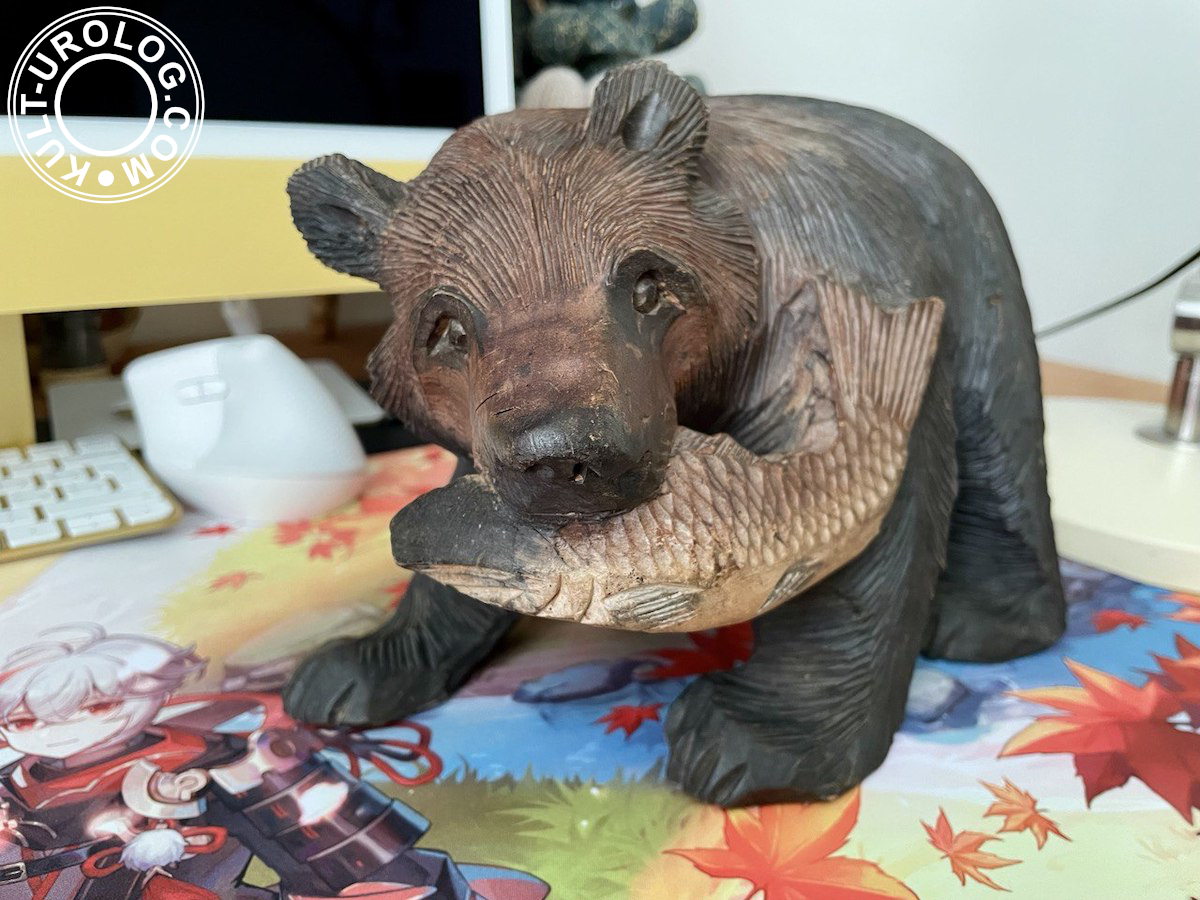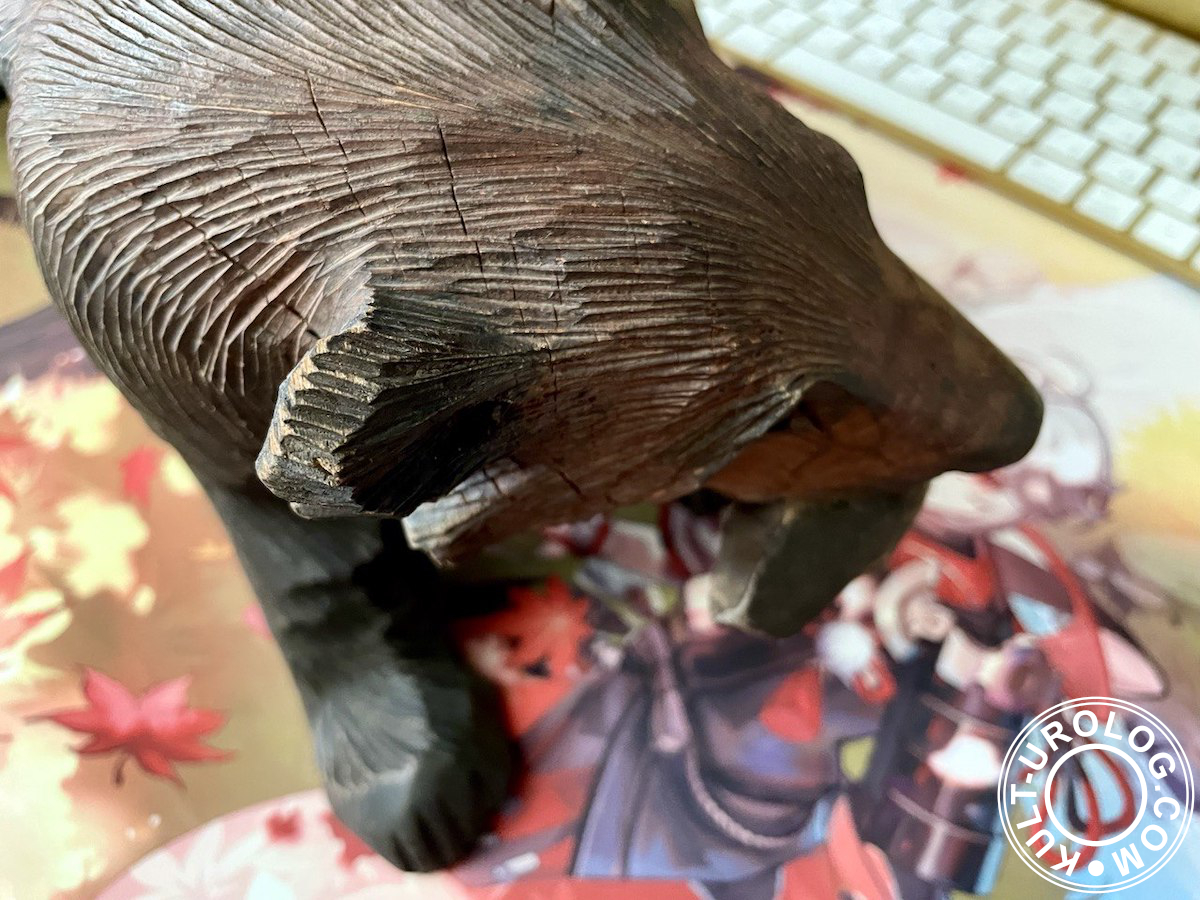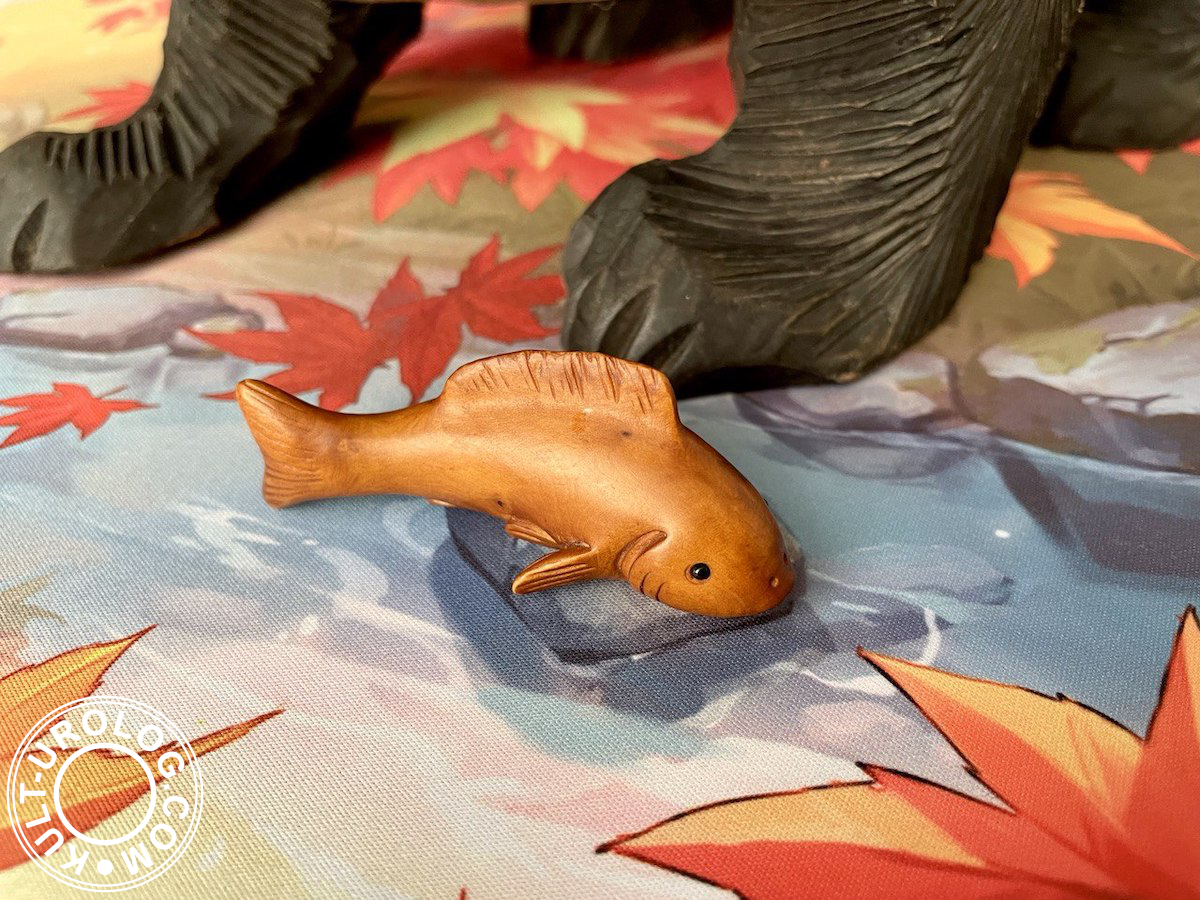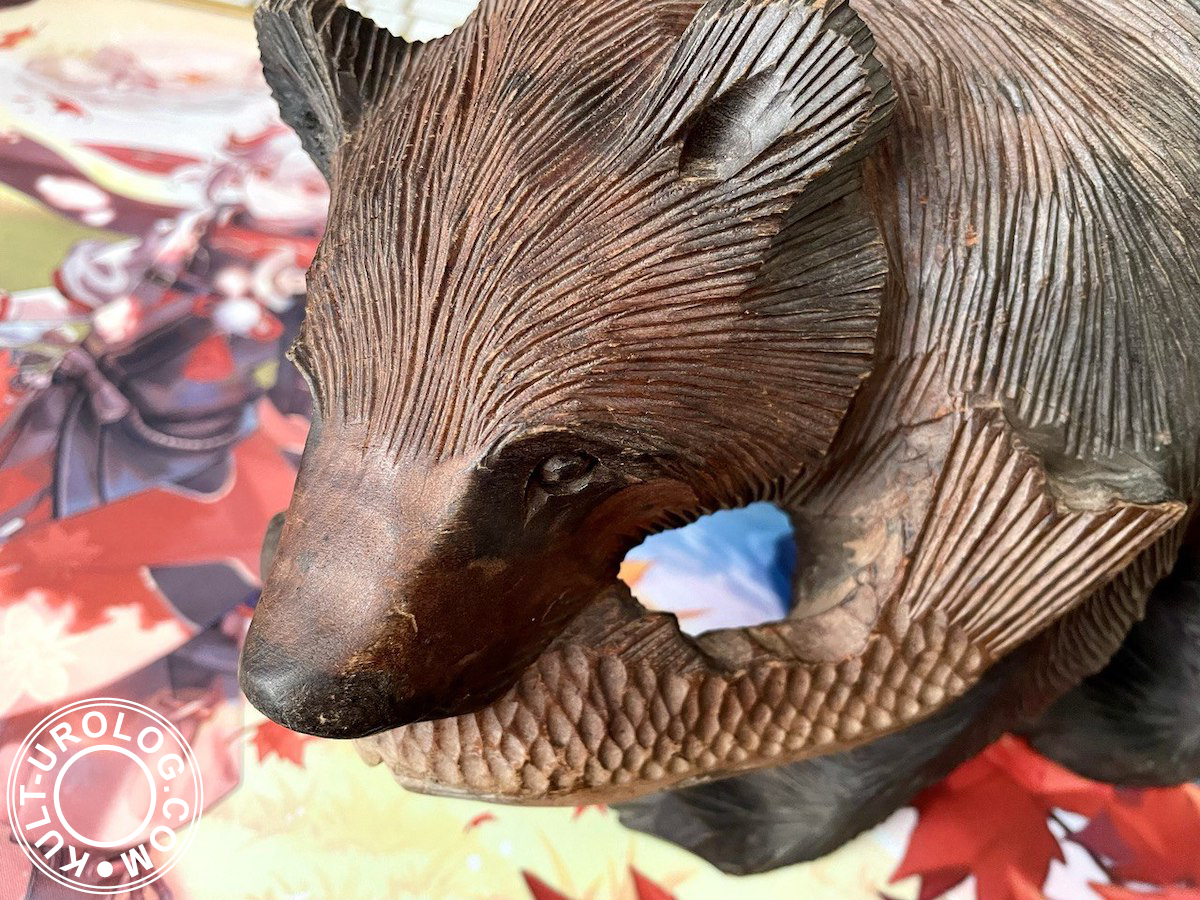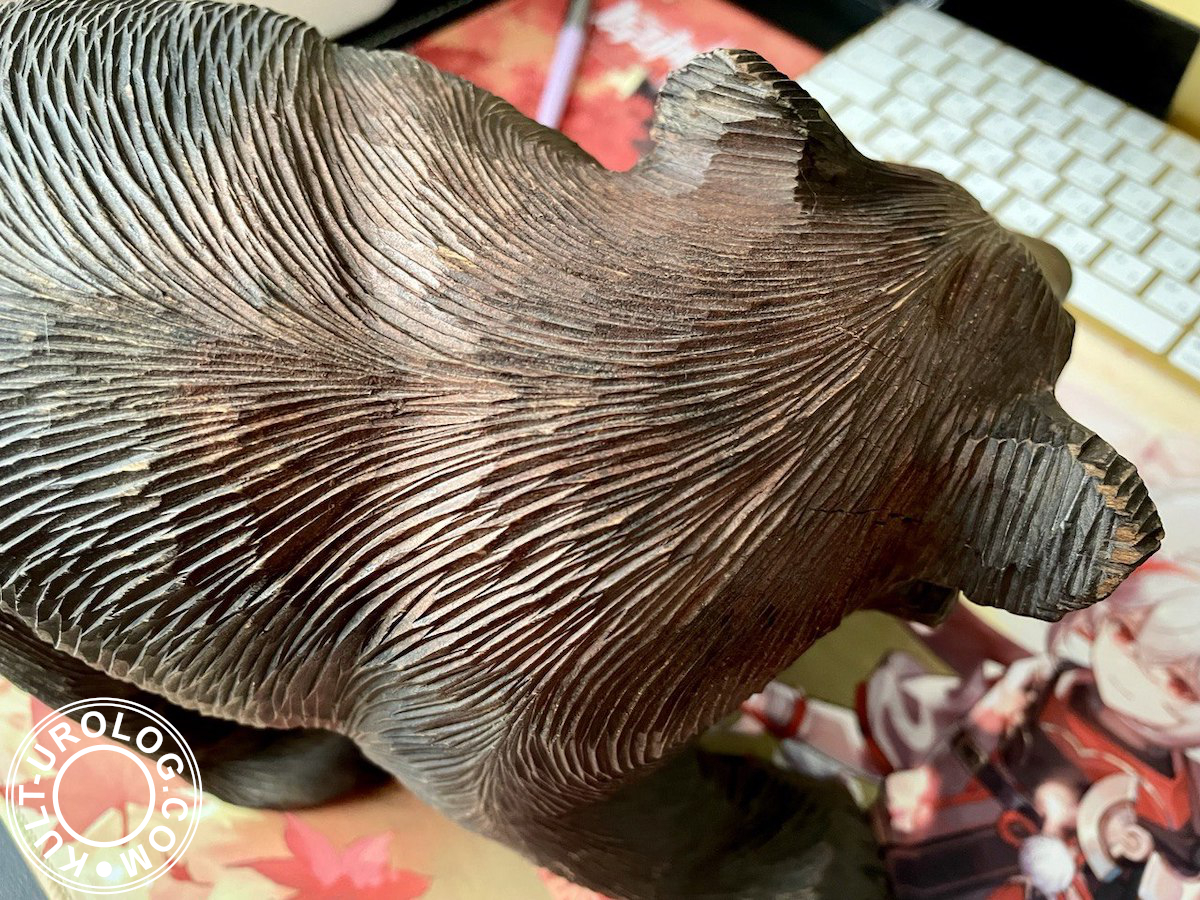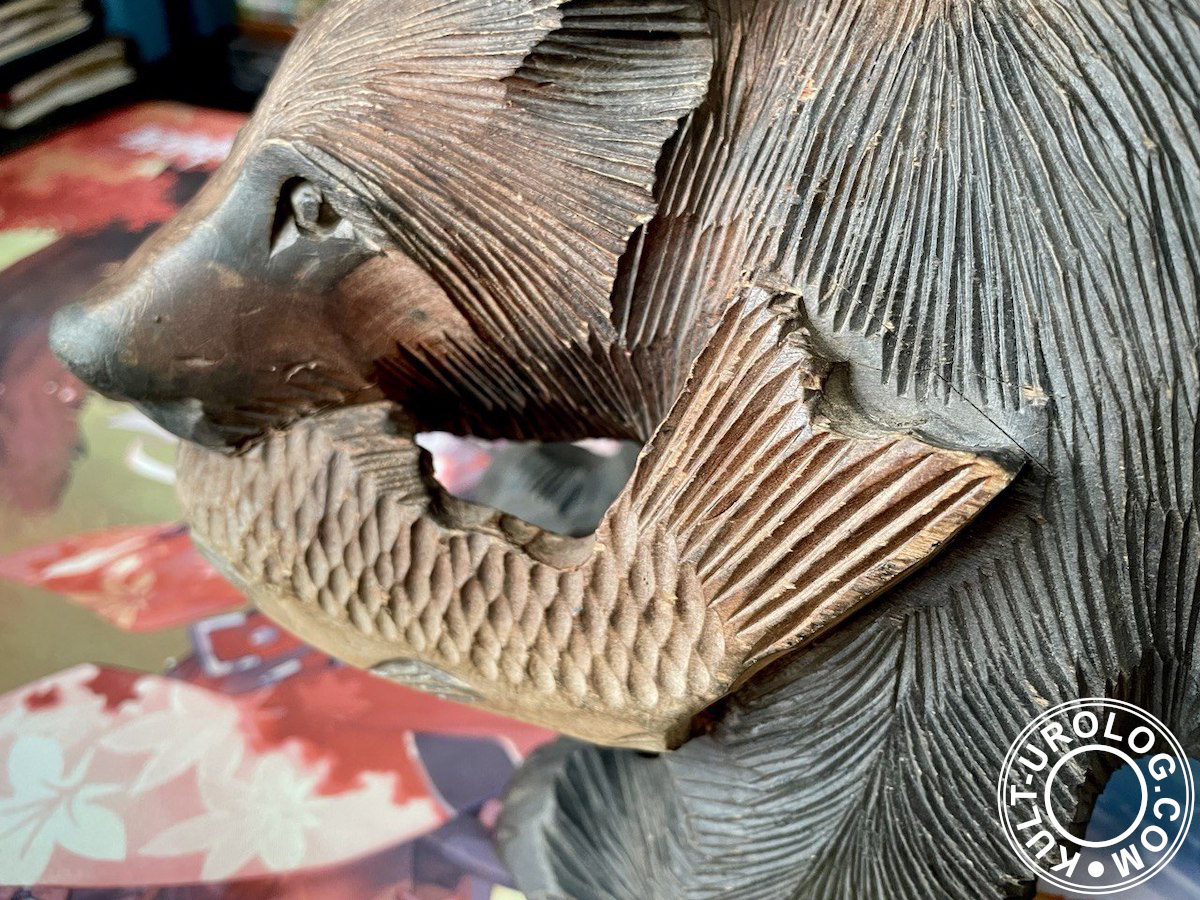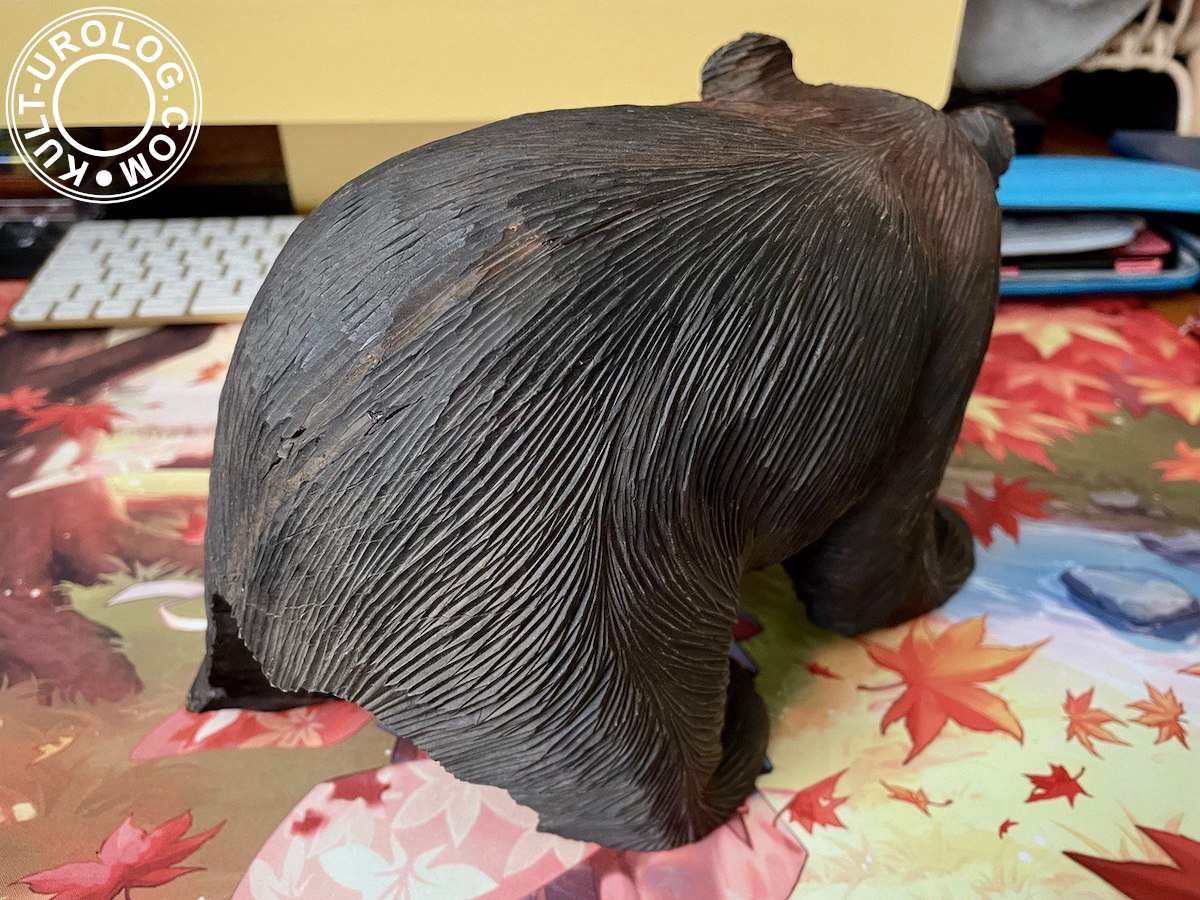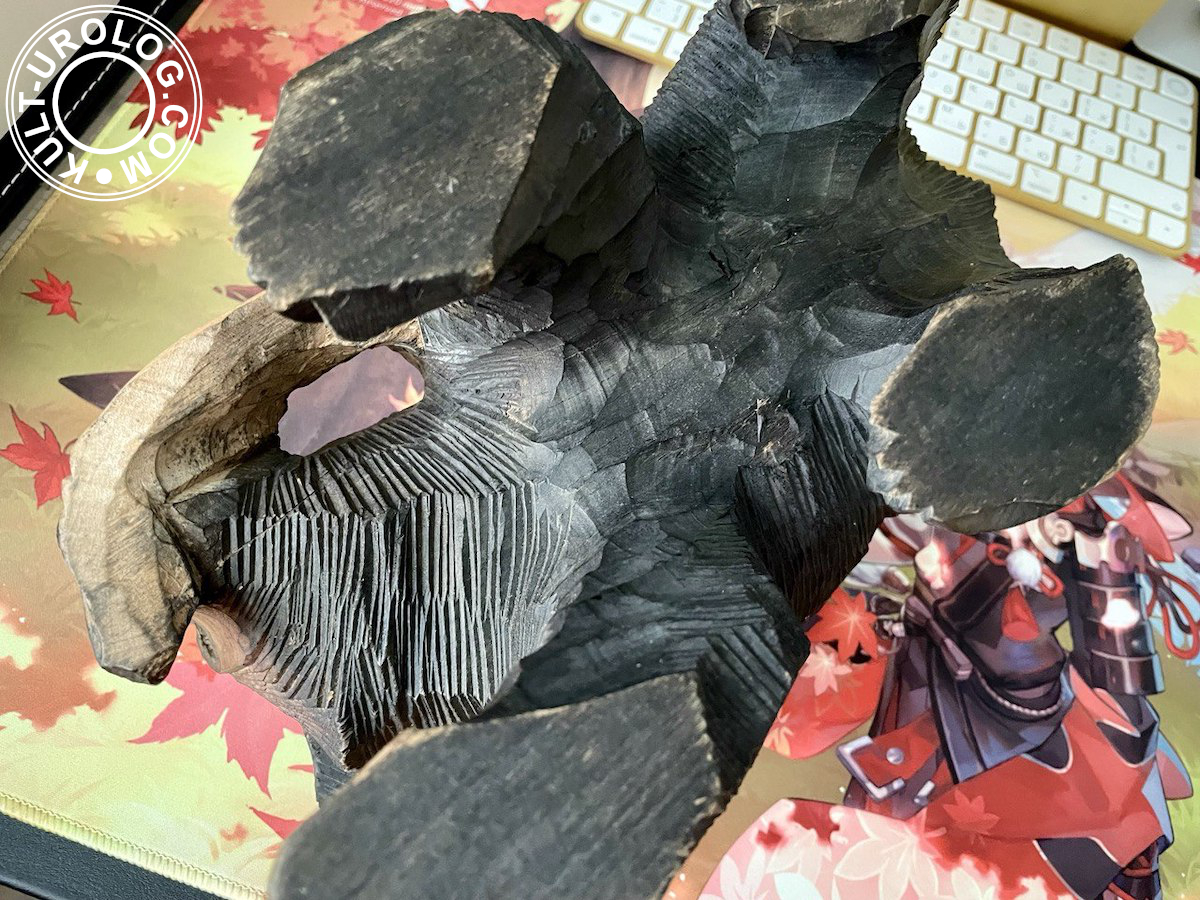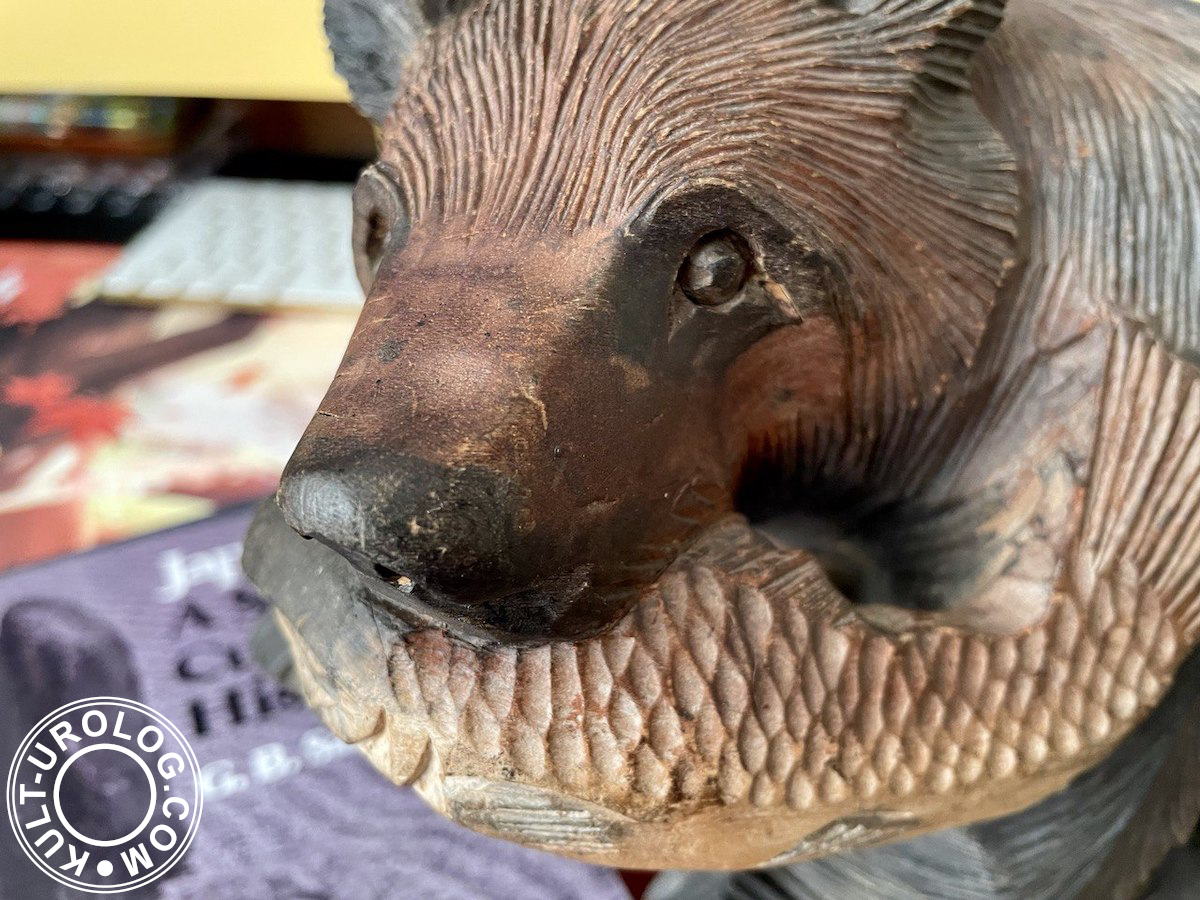I’ve been planning to add a Hokkaido bear to my collection for a long time, and I finally did it.
This is a rare beast. Not for Japanese flea markets, where their population is represented quite widely, but in general. It is difficult to find it, it has to be visually pleasing (and for an affordable price), there are usually only a few of them available for online shopping (the range of kokeshi or other Japanese wooden toys is wider), not all the items are delivered to the Czech Republic, they are quickly sold out.
Finally, I was lucky enough to find «my bear».
The Czech customs checked it thoroughly, and two weeks after placing the order, our bear finally arrived from Japan.
On the way from the post office, we took the bear for a walk around the area, because he definitely needed some fresh air after traveling from the other side of the world in a cramped box (and also it was hard to let him out of hands after checking the box, if everything was all right: he lies very well, like a kitten).
And what can I say: walking a bear, even a wooden one, attracts a lot of attention. He turned all heads, and many Prague residents got acquainted with Hokkaido bear that day.
Once we got home, it was time for cleaning. The paint, with few exceptions, remained in place (which is nice, because this was the most worrying thing), but the dust, of which there was a lot, was removed, so the bear began to look fresher.
Our bear is small. He weighs only one kilogram and is 17 cm tall. He comes with salmon and stands on all fours (in case the pictures don’t show it well). He is from the 60s, so he has cracks, chips and peeling paint. The outlined contours, straight lines and cuts, also became wider and deeper over time (it’s a miracle he survived the postal delivery). But even in such a condition, it looks better than on pictures, as all the Japanese products do (it seems to be a custom there: to take photos of goods as badly as possible).
The bear smells like old cedar (or pine), and it doesn’t matter of which wood he is actually made (but the smell is strong). (UPD 11.05.2025: Now it smells like a museum of medieval sculpture and old furniture, most likely made of linden.)
He looks like an old friend or a childhood memory, and it’s not just a coincidence.
I saw a lot of such bears on Instagram, but I never saw them in old Japanese movies or anime (there were kokeshi, kendamas or anti-mosquito butas, but bears — never; and they didn’t look completely Japanese). Although for some reason I was sure I knew these bears before. (UPD 19.08.2025: Actually, there was one such creature at Motoba’s house in «Himouto! Umaru-chan», but who remembers such details after ten years?)
Bogorodsk toys, with which Hokkaido bears can also be compared, are more childish and their specific trait is the presence of moving parts, also, it is definitely not the same species as the bears in Siberian and Far Eastern souvenirs (first of all, he’s got no balalaika). There has to be another option.
As it turned out, the answer was not in the East, but in the West.
I wasn’t satisfied with the English version of the Wikipedia article (it doesn’t contain complete information, which makes some statements not entirely correct), so I had to make my own research and to read through a lot of sources. Now, my little readership, you’ll have to read a lot, too.
As a bonus, everyone can enjoy the view of my new Genshin Impact desk mat with Kazuha here. Because, firstly, it looks attractive, and secondly, nothing goes better with a bear with a fat salmon than an autumn landscape (although there is a competition now: who smells stronger, the bear with wood or the pad with rubber).
The famous Ainu bear is actually called Kibori kuma (木彫り熊, «carved wooden bear»). It is a traditional Japanese craft object, representing an Ussuri brown bear (in Japan, they live exclusively in Hokkaido, the rest of the country is populated with the subspecies of the Asiatic black bear), carved in wood, often depicted with a salmon in its mouth. This okimono (literally — «ornament», a Japanese sculpture, similar to a netsuke, but larger, and with a purely decorative function), particularly widespread on the island of Hokkaido, has become a significant element of this region, where it is sold as a souvenir.
These sculptures are also known as kibori no kuma (木彫りの熊), kuma no kibori (熊の木彫り) or kumabori (熊彫り). They represent the animal in different postures: standing, sitting, crawling or, the most common representation, biting a salmon.
In Hokkaido, bears are everywhere (mostly on warning signs), and the Ainu, the indigenous people of northern Japan and Sakhalin (north of Japan), are closely associated with worshiping bears and rituals involving bears (but don’t Google it if you are not ready to see how animals die in the end), so it seems logical that the island’s main souvenir is a wooden bear. And this bear was carved by some Ainu.
But, despite the frequent association with traditional Ainu crafts, these sculptures are not native to their culture. Traditionally, the Ainu avoided depicting animals or humans in a realistic manner, believing that such representations have souls and could do evil, so they don’t carve realistic figures of animals, plants or people into wood, don’t draw them, and don’t weave them into textiles. It was even more unthinkable to carve a realistic brown bear, which is considered a kamuy, into wood. From the other hand, remains with bear-shaped designs were unearthed from Hokkaido ruins of the Late Jōmon and Satsumon periods. Also, in Ainu culture, figures of bears and orcas were sometimes depicted on ritual items (on the front of sapanpe, a ceremonial crown, or on ikupasuy, a sacred wand used to make offerings (alcoholic ones) to gods and spirits).
The origin of kibori kuma dates back to 1921 when Tokugawa Yoshichika, the 19th head of the Tokugawa family (man of many talents and a so-called Tiger Hunting Lord, because he liked tiger hunting (though he did not disdain bears, too), and also a friend to the Ainu), purchased two sculptures representing bears (one on all fours, the other — standing and holding a bobbin of thread) as souvenirs in Brienz (an extremely picturesque village close to Bern, Switzerland) during a European trip from 1921 to 1922. Returning to Japan in 1923, he took them to the Tokugawa farm, an experimental farm settled by former Owari samurai and located in Yakumo (Futami District, Hokkaido).
And here we will give a brief historical background.
After the Meiji restoration all of the Samurai became jobless civilians.
But along with the Japan modernisation and the first Constitution, Tokugawa Yoshikatsu, the 17th head of the Owari Tokugawa family, was granted with the free of charge land in Hokkaido to help the impoverished samurai of Owari (servants and their descendants), and to settle them there so they could practice agriculture (and to make the northern lands of Hokkaido more Japanese, as a part of the Japanese government’s project to develop various territories in Asia; also, it was a nice way to get rid of some representatives of a rather dangerous class, who clearly weren’t happy with the changes).
So, many of unemployed former retainers of the family were sent up north to pioneer the new land. It included potato farming, logging, dairy farming and being poor (with no cultural entertainment). The name of the settlement was chosen from a line of Susanoo’s poem in the Kojiki, that’s why Yakumo is one of the few place names in Hokkaido that doesn’t originate from the Ainu language.
As an ex-lord who cared about his ex-vassals, Yoshichika decided that something had to be done. Therefore, he brought with him about twenty items of European folk art: ashtrays, bowls, plates, paper knife letter opener, some other items and two Swiss bears (Bernese and Brienz craftsmen carve different animals from wood, so the choice was surprisingly accurate). He suggested to the farmers, and to the nearby Ainu people, that they use this models to produce similar woodcarvings as a source of winter income. Yoshichika invited artists from Tokyo to do seminars on the art of carving, and offered the pioneers to buy all the products they produced, no matter whether they were good or bad. The audience, after much trial and error, chose to focus on carving the bears (well, bowls are not fun, and a paper knife letter opener even sounded too odd, so, yep, it is easy to understand the choice).
But Yoshichika was unable to persuade Ainu, so all Yakumo bears were carved exclusively by the Japanese (to be more precise, by descendants of servants of the Owari-Tokugawa family), and the first to succeed was Masao Ito, who carved his first bear in 1924.
The same year, the first bear sculptures from Hokkaido were presented at an exhibition of rural arts and crafts in Yakumo, organised by Yoshichika to promote the folk art (i.e. the result obtained). So the history of Hokkaido bears, starting in Taishō era, goes back more than 100 years.
In 1927, one of these bears won a prize at a National Exhibition and was presented to Prince Chichibu Yoshihito. The following year, a bear carving exhibition was held to commemorate the 50th anniversary of Yakumo’s colonisation (or foundation, if you wish). These initiatives popularised kibori kuma throughout Japan, all happening almost at the same time, when the concept of Mingei was finally developed.
Yakumo’s wooden bear carvings, another successful Japanese adaptation of something Western (a common thing at the time), gradually became well-known to the public. When new Hokkaido souvenirs gained national attention in 1932, they were already very different in style from their Swiss prototypes, which was the beginning of what we now call Hokkaido bears (for example, even if first generations of pre-war bears had red painted mouths and glass beads for eyes, like Brienz bears, some of the Yakumo artisans used nails instead of beads — small, but very important difference).
In the early Shōwa era, during the 1930s, production reached approximately 5000 units per year.
The proximity to Japan’s 7th Army Division encouraged the sale of these sculptures as souvenirs for military families from Honshū.
But the vast popularity subsequently increased during the Shōwa era thanks to postwar tourism boom, peaking in the 1960s and 70s, and Hokkaido island, once called a «barren land for local toys», became known nationwide thanks to its wooden bears.
Hokkaido bears look more real than their European ancestors and cousins (the Swiss and the German ones are too elaborate, sometimes almost heraldic, as befits European arts and crafts). And even if it’s not an independent genre, but something borrowed, the observations of bears in the wild northern nature helped anyway.
This wooden sculptures are made with a few precise strokes, like in calligraphy, which gives us an illusion of movement, so bears look more alive (although sometimes more abstract).
Many variations of bear sculptures have developed over time. Not only are their poses and expressions extremely varied, but the carving methods also vary slightly depending on the region (but they all usually are made from a single wood block, all are hand-carved, using customised knives and chisels, and all are unique).
Usually, only two streams of carved bears (the first is Japanese, the second is Ainu) are mentioned everywhere, but according to the article on Reverse.Gem (to which I owe a lot), there were three different streams. They are named after the regions of their origin: Yakumo, Asahikawa and Naie (Horii).
Yakumo bears are easy to distinguish from the rest (it is even easier if there is a stamp on the bear’s paw). The originality of the sculptures was evident in bears’ shapes: they were thick and round, as befits domestic animals. And they often have unique carving textures. Namely: menbori (plain sides without fur lines), kattobori (knife cuts), and hatsuribori (axe cuts).
The city of Asahikawa was famous for its woodcarvers long before, and there were many workshops. However, although the original style of woodcarving was created by Ainu craftsmen, by the time kibori kumas appeared there, most of the Ainu had been assimilated and can be considered Japanese carvers.
The production of bears began there in 1926, thanks to a young hunter and a craftsman of Ainu descent Matsui Umetarō. He was from a new generation, and he felt less pressure from tradition (or was it a result of Japanisation? who knows?). While hunting, he saw and then could not forget a bear with a wounded paw, so he decided to carve its image in wood.
Thus, Asahikawa got its own kind of bear.
When Emperor Hirohito visited Hokkaido in 1936 (Shōwa 11), wooden bears were presented to him from both Yakumo and Asahikawa.
Asahikawa wooden bears are the most realistic of all, because the Ainu focused on the wild ones. They were not only carvers, but also hunters, so their connection to real forest animals was closer.
While two domestic bears (a boy and a girl) posed for the craftsmen in Yakumo, becoming thicker from year to year, due to which the typical Yakumo carvings gradually became rounder and kinder (the main distinguishing feature of the carvings from this city), the Ainu saw in the forest thinner, more muscular and, of course, more aggressive bears (and when people think of Hokkaido wooden bears, they usually imagine the Asahikawa’s ones).
Here we have to mention, that not all the masters treated the bears as humanely as in Yakumo. This art sometimes was cruel to animals. Carvers were often hunters, so they hunted bears to study their anatomy (and not only to study: bears always were the big game in Hokkaido). And the story of the Yakumo pets also ended sadly: during World War II, their metal cages were confiscated for the needs of the army, and the bears were killed. Art demands sacrifice, and genius and villainy are two things incompatible. Something like that.
The third branch, founded by a team of carvers led by Seiji Horii (it was modestly called «Horii Mingei»), first made bears in the Asahikawa style, but then developed so much that it became an independent style. They were located in the city of Naie, near Sapporo. And it was Horii who cut and then presented the bear to Emperor Shōwa.
The Horii bears often look like the Asahikawa bears, but they are thinner and more friendly, and often have glass beads for eyes (like original Swiss bears) and stamps on the bottom of their paws. Such a logo is a silver or white outline of a bear’s head with the word «Horii».
Bears with salmon in their mouths look kinder, without salmon — angrier (of course, they do). There are dark and there are light sculptures. The ones with salmon usually look to the left, but sometimes to the right. Some have a base, others have nothing but paws (on which you may see a stamp or a maker’s signature, sometimes even the date or location, where a bear was carved, but it’s not a necessary element, often only large bears have marks like this).
Among the many variations and forms of Hokkaido bears (including furniture), there are a number of characteristic types of their poses: standing bear (tachi kuma), sitting bear (suwari kuma), climbing bear (nobori kuma), standing on all fours with its mouth closed bear (kuchitoji kuma), standing on all fours with a salmon in its mouth bear (shake gui guma), carrying salmon on its shoulder/back, standing or on all fours bear (shake seoi kuma), standing on all fours with its mouth open — barking bear (hoe kuma), holding a salmon in its paw, standing on the other three legs barking bear (shake mochi hoe kuma), swiping its paw and standing on three legs angry bear (ikari kuma), holding a cub in its mouth and standing on all fours bear (oyako kuma).
The sculpture technique also has more or less detailed variations: carved in a rough way, giving the bear a more polygonal shape, or carved with more detail, going so far as to give a relatively realistic result, especially in terms of the fur.
The more intricate the carving is (such as carved hair lines and bristles), the more valuable is the bear. On the other hand, some bears in the menbori cube style of the Yakumo’s early designs (the legend says, even the famous British ceramicist Bernard Leach owned a few kibori kumas without finely carved fur — and it was a long time ago), can be much more valuable.
There are different types of wood used for carvings: pine and cedar, chestnut, Japanese linden tree, Japanese Yew, Japanese pagoda tree, aralia, and bog-wood. Usually it’s a light wood. If the craftsman wants to emphasise the natural pattern and texture, the coating is made transparent, or the wood is burned (the appearance of the sculpture also depends on whether the craftsman carves the piece along or across the tree trunk).
Most of the bears are painted dark brown and black.
There is no standard paint. To make a bear black some carvers use sumi (ink), watercolours or lacquer, sometimes it can be even a shoe polish.
Bears can be very tiny (1 cm) or very large, almost of the size of the real animals. And there is a rule by which the size of a wooden bear is determined. Japan used its own units of length before the introduction of the metric system, so they measure in suns (1 sun is slightly more than 3 centimetres). The size depends on how many suns there are from one outer side of the front paw to the other. So a 6-sun bear on all fours, which is the most popular size and shape, would be a size 6 and so on (and the system changes slightly for standing bears, but I don’t know how exactly).
I’m not sure if this is all correct, but the trap of studying Japanese culture is that the volume of literature in any other language is so vast that you can forget to learn Japanese language (no time for grammar, knowledge awaits!). So let’s just assume that I got all this classifications right.
In the past, it was common for every household to have one (or a few) wooden bear carvings from Hokkaido, but later their presence faded. Once very popular, today they are no longer the main souvenir item.
Instead of buying things, tourists started to take pictures, because cameras became more accessible.
Later, the leading role of Hokkaido souvenirs has been taken over by the ever-growing variety of sweets and seafood, which can now be brought home fresh thanks to the development of freezing technology. Heavy, expensive and space-consuming okimono can’t compete with food in convenience. And Yakumo, the only town in Hokkaido that borders both the Pacific Ocean and the Sea of Japan, is plenty of delicious seafood.
Changes in living environments have dealt a further blow. As televisions got thinner, there was no longer any space above to display souvenirs, so the wooden bear carvings had nowhere to go (they just fall from there, and if the LED panel is attached to the wall, they don’t fit at all; but it’s a mediocre joke, I know). Japanese population density increased, houses became more crowded, and things began to shrink to take up less space. No big apartments anymore, no extra space, only Marie Kondo to save us all (though we have to admit, in the beginning, in those dark days even Marie wasn’t around).
The shiny black bears, which looked too gorgeous and too old fashioned for modern interiors (often oriented toward simplicity), became unnecessary, and were sent to the closet (just like brown bears and Asiatic black bears, which have lost their habitats due to development, Hokkaido wooden carved bears have also lost their habitat).
And what an amazing world we live in: not only people consider Hokkaido bears cute now, they started to think they go well with the same, or even more simple interiors.
On the other hand, since the beginning of the 21st century, a movement has emerged to reassess kibori kumas as traditional arts and crafts and to explore their origins academically, led by Associate Professor Abe Yoshinobu of Hokkaido University of Education.
On April 25, 2012 (the year that Wikipedia for some reason considers to be the beginning of the end of kibori kumas, reporting that there was only one master left), the Yakumo Woodcarved Bear Exhibition Room was opened in the Yakumo Local History Museum, and two years later, it was renovated and opened as the Yakumo Bear Woodcarving Museum. The museum displays a number of wooden bears, including a wooden bear brought back from Switzerland by Tokugawa Yoshichika, the first carved bear from Hokkaido, autographed cards by celebrities (by Nara Yoshitomo, among others), and bears carved by modern artists (not necessarily «bear-oriented»: for example, Nemoto Isao is a kokeshi master). The admission is free, photography is prohibited for the bears that were brought from overseas and served as models.
In addition, a monument was erected on the grounds of the Yakumo Town Community Center (where the museum is located) to commemorate the origin of wooden bears in Hokkaido.
Yakumo is a tourist destination again.
Although even if you can see famous bears there, it is hard to find a wooden bear to purchase. But the newly opened stores and coffee shops sell bear-souvenirs (key chains and other useful things) and sweets, including biscuits and ningyo-yaki in the shape of a bear’s face (visitors also can take one of the bears, which are usually widely displayed in such places, to their table — to drink coffee in good company and better feel the atmosphere of the city).
And of course, for all the enthusiasts Yakumo Town proposes the Wood Carving Bear Course (which means: this skill is not necessarily passed down from generation to generation).
Kibori kumas make a comeback thanks to social media, too. Posts with hashtags like#木彫り熊 or #木彫りの熊 (both mean #woodcarvedbear in Japanese) started to appear on Instagram almost ten years ago, and the interest in wooden bears from Hokkaido, which were previously unnoticed by anyone except a few hobbyists who loved Shōwa retro, began to grow.
Along with newfound popularity, exhibitions of masterpieces of wooden bear carvings began to be held in Tokyo (and other big cities) from time to time. And an exhibition of Hokkaido bears held at the one of CLASKA Gallery & Shop DO select shops in the summer of 2019 attracted more than 8000 visitors.
Publications and illustrated catalogues began to appear, full of adoration, lots of photos of bears and interesting information, such as a classification of woodcarved bears and the differences between the wood cutting of Yakumo’s and Ainu (but, no matter how much time has passed and new artists appeared, people are still huge fans of the first ones).
New versions of Hokkaido bears appeared (sometimes becoming associated with popular brands). They include, among other things, a bear whose role is reversed, so he is bitten by a salmon, a Magikarp that jumps and hits the jaws of a crawling Ursaring, a bear with a bottle of sake, and other forms of toys such as plastic figures for gachapon vending machines, or even plushies, often small in size, sold as bag charms.
People began to realise that there was actually a wider variety of styles than they had imagined, and that there was an interesting history behind it.
In addition, new carvers appeared. For example, Takano Yuki, and Jiro Hikima, both working with Yakumo traditions. And it is said, wooden bears by Takano Yuki, are so popular that long lines form on the day of arrival and they sell out within minutes.
Collectors have appeared both in Japan and abroad, and wooden carved bears, once considered «unfortunate ornaments» symbolising the Shōwa era (there was a lot to remember, but more to forget), became not only popular again, but also very expensive (around 2020, the price sometimes could reach the sum over 500000 yen for a one bear at an online auction).
Many of the buyers are not nostalgic, but rather future-oriented people who incorporate wooden bears into their lifestyle as art pieces. Also, in our age of cold and heartless mass production, we need something warm and cosy, even for modern interiors full of design objects. Wood ages beautifully, and a lot of Hokkaido bears are already old (and beautiful), so they make every living space look better automatically.
Until very recently, wooden bears were often refused by second-hand dealers because they were difficult to sell (though a lot of them still were presented at antique shops), now it is a large market (and everything changed not only for bears, kokeshi and other good old Japanese stuff and Japanese-wood-carved-everything are back as well). And for naive and not very educated buyers there is finally a full range of fake bears (by the way, some European antique stores sometimes present Hokkaido bears, which are still not very expensive, as their overpriced colleagues from Bern or the Black Forest, so knowing the differences can be useful in this case).
Our bear is very cheap compared to real collectible rarities (and to many other things). And since we bought it in Japan, it’s even cheaper (European stores usually charge more). But it doesn’t matter. I’ve been looking for the right Hokkaido bear for myself for a long time (at least two years since I decided that I need it; Hokkaido bears are in vogue, like a lot of other old things these days, and I’m just another fashion victim; but it’s okay, I like it). And this Hokkaido bear looks right (and has the right mood).
He may not be as shiny, nor as big, but has a beautiful carved fur and looks calm with the salmon in his mouth. He’s not hungry, he’s just fattening up for hibernation. And a calm bear is a good thing, trust me. This is a must-have for any forest. And it doesn’t matter in what corner of the globe this forest is located.
